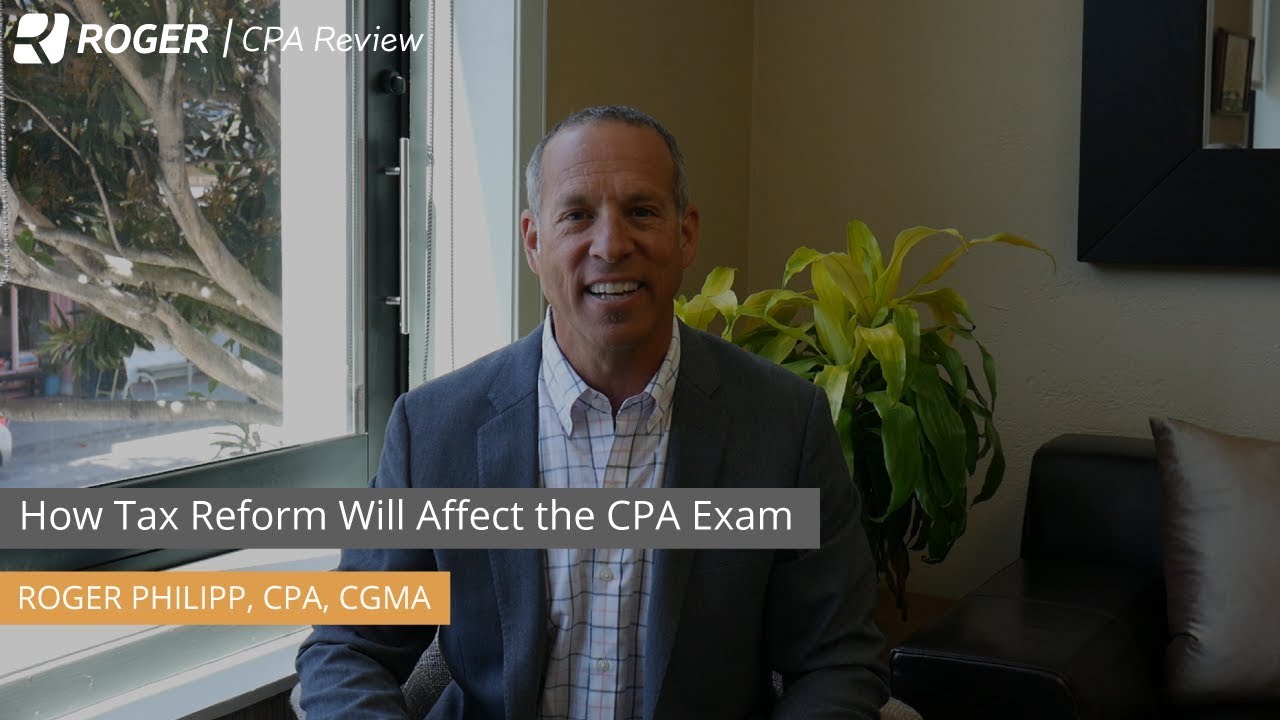
The Tax Cuts and Jobs Act was signed by President Trump and became public law on December 22, 2017. The tax overhaul is the first of its kind in over three decades and has significantly reformed both individual and corporate income taxes. The AICPA announced the new law was eligible to be tested on the CPA Exam on January 1, 2019.
Tax Cuts & Jobs Act Overview
In a nutshell, this new Tax Reform is:
- Lowering the corporate tax rate from 35% to 21%.
- Increasing the standard deduction from $6,000 to $12,000. If you’re married and filing taxes jointly, that’s a standard deduction of $24,000; Therefore, many people who used to itemize through Schedule-A will no longer need to do so.
- Increasing the child tax credit from $1,000 to $2,000 and changing the phase out threshold up to about $400,000. This would allow most Americans to qualify and receive the $2,000 benefit, which will help stimulate the economy.
- Limiting itemized deductions on the Schedule-A. A good way to remember this is through a mnemonic I commonly use to teach, which is “COmMITT this to memory”:
- C – Charity
- Om – Other miscellaneous
- M – Medical
- I – Interest
- T – Tax
- T – Theft & casualty
- Creating a new 20% Qualified Business Income deduction to lower tax rates for owners of certain pass-through entities & sole proprietorships (S-corps/P/s). This is probably one of the biggest changes we’ve had throughout the entire tax code in the past 30 years. So it not only significantly changed individual taxes, but also business entities, which a lot of you may be studying, or have studied in school already.
Recommended Articles

Top 10 High-Paying Accounting Jobs
The employment of accountants and auditors is projected to grow 11% from now until 2024, revealing just how in demand accountants are nationwide.

Top 10 High-Paying Accounting Jobs
The employment of accountants and auditors is projected to grow 11% from now until 2024, revealing just how in demand accountants are nationwide.

Top 10 High-Paying Accounting Jobs
The employment of accountants and auditors is projected to grow 11% from now until 2024, revealing just how in demand accountants are nationwide.

Top 10 High-Paying Accounting Jobs
The employment of accountants and auditors is projected to grow 11% from now until 2024, revealing just how in demand accountants are nationwide.

Top 10 High-Paying Accounting Jobs
The employment of accountants and auditors is projected to grow 11% from now until 2024, revealing just how in demand accountants are nationwide.
Tax Reform Q & A
While it may seem that this Tax Reform is mostly relevant to individuals and businesses, it of course also has some bearing on your future as an accounting professional. Here are some ways this Tax Reform will benefit you.
- Increased marketability. The reliance upon accountants to make sense and to understand all of these new accounting tax changes has increased. This not only means more accounting jobs, but accounting jobs that are in high demand–especially for those of you who may specialize in taxation. It also prepares you to enter a career where you’ll be offering this amazing advice about how all the new tax laws will affect your clients’ finances, as well as their financial statements.
- Updated curriculum. If you haven’t completed your tax classes in school yet, then you might decide to hold off a little longer, or at least as long as possible until the curriculum is updated to reflect the Tax Reform. Normally, a publisher is about 1 to 1.5 years behind, which means that current textbooks still cover the old rules. Most universities are working on ensuring that the accounting textbooks are aligned with the new tax regulations, but until that happens, it might be your best bet to wait on taking your tax courses until they do.
- Increased value of the CPA designation. Obtaining your CPA designation is more valuable now than ever before. Being a CPA in conjunction with specializing in tax will provide you with a variety of career opportunities—especially if you want to go into public accounting, which now typically requires a CPA designation due to the increase in demand. However, even if public accounting isn’t for you, having those three letters behind your name will set you apart from other job candidates. It also looks great on your resume and can give you priority over others.
- It will change the REG section of the CPA Exam. The content areas that are most affected on REG will be taxation, which makes up about 80% of the exam. This includes federal taxation of property transactions, of individuals, and also federal taxation of entities, like a C corp, S corp, and partnerships. Estates and trusts will also be changed, or—what I like to call—gifts and stiffs. For example, instead of $14,000, your parents can now legally give you $15,000 a year. Estates have also been doubled to about 11.2 million dollars. These are a few of the changes that candidates can expect to see on the REG section in 2019.
- If you want to avoid those changes, sit for the REG section of the CPA Exam now. The AICPA stated that the new tax changes won’t be tested on the REG section until January 1, 2019. Therefore, we recommend that you sit for REG now, in 2018, before January 2019 hits. Why? Because everything you studied in college, whether it’s individual taxes or entities, is going to be on the Regulation section of the CPA Exam all throughout the remainder of this year. You won’t need to learn new material, and the material you’ve already studied thus far won’t be obsolete.
- Need help fitting REG into your busy schedule? Enter our new patent pending SmartPath Predictive Technology™—the most effective way to maximize your study time. This data-driven platform shows you exactly what to study and how much, taking the guesswork out of CPA Exam preparation. Also, it’ll help you pass faster than ever before.
- Not prepared to sit for REG this year? Don’t worry about it. Because as a Roger CPA Review student, your study materials will automatically be updated to prepare you for the REG changes in January 2019. So, no matter when you decide to take the REG Exam, we have you covered, and we’ll guide you on the SmartPath to CPA Exam success.
Now, the tax reform will impact all the sections of the REG exam starting in January of 2019, accounting for as much as 80%. As a result, the AICPA has been busy turning the exam upside-down, shaking out all the broken pieces and putting it back together with revised and new multiple-choice questions and task-based simulations.
Normally, when material on the CPA Exam changes, there is a 6-month lag for when it can actually go into effect and be eligible for testing. Therefore, although the Tax Reform passed in December of 2017, it impacted the Regulation section so much that the AICPA needed time to reflect the changes in that section, thereby making it eligible for testing in January of 2019.
There are several different types of changes to keep in mind here.
Some of the provisions are going to be totally repealed and not replaced. For example, there’s no more alternative minimum tax, or AMT, for corporations. They still exist for individuals, but it’s been repealed for corporations.
There are also quite a few changes that have been made permanent mostly for corporations, such as a new flat 21% tax rate versus the old graduated tax rate system. The new rates are changing from 70% to 50% and 80% DRD to 65%, so say goodbye to those old percentages; unless, of course, you take the exam during 2018 before 2019, then all those rules that you’ve already learned will still be in effect.
Where it gets a bit tricky is when we get into the high volume of individual taxation changes, where many of them are temporary. For example, alimony rules are changing, which means that if you get divorced before 2019, the current rules still apply. However, if you get divorced after 2019, alimony is no longer deductible, and it will not be taxable to the person receiving it.
There are also some tax provisions that are entirely new and slightly complicated, like the 20% qualified business income deduction, QBI, which is for certain pass-through entities like escorts and partnerships. The IRS still doesn’t have all the answers on this one, which is why it’s still a bit gray.
As the REG section evolves and changes to reflect the new tax reform, so have the REG blueprints. You’ll notice that some of the obsolete items like corporate AMT have been removed from the blueprints, and new areas and topics that weren’t tested before and most likely won’t be tested in the future, have also been removed.
However, this doesn’t mean that a new deduction, for example, wouldn’t be testable. A new deduction for individuals would be testable under what we call topic C, which is adjustments and deductions to arrive at AGI and taxable income. It also doesn’t necessarily mean that you won’t see any new representative tasks, since these are just examples of what you might see tested under a topic.
In summary, be ready to embrace the effects as well as the opportunities that these changes provide for all of us in the accounting profession.